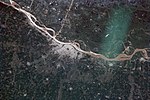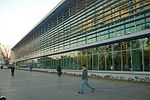Estadio Cubierto Newell's Old Boys
Argentine sports venue stubsIndoor arenas in Argentina

The Estadio Cubierto Newell's Old Boys (English: "Covered Stadium of Newell's Old Boys") is an indoor arena that is located in Rosario, Argentina. It is primarily used for basketball games, and other indoor sporting events. It holds 7,500 people for basketball games, and up to 11,400 spectators for concerts. It was opened in 1982 to host the II South American Games.
Excerpt from the Wikipedia article Estadio Cubierto Newell's Old Boys (License: CC BY-SA 3.0, Authors, Images).Estadio Cubierto Newell's Old Boys
Avenida Daniel Infante, Rosario Parque (Distrito Centro)
Geographical coordinates (GPS) Address External links Nearby Places Show on map
Geographical coordinates (GPS)
| Latitude | Longitude |
|---|---|
| N -32.955277777778 ° | E -60.6625 ° |
Address
Estadio Cubierto "Dr. Claudio L. Newell"
Avenida Daniel Infante
S2000 Rosario, Parque (Distrito Centro)
Santa Fe, Argentina
Open on Google Maps









